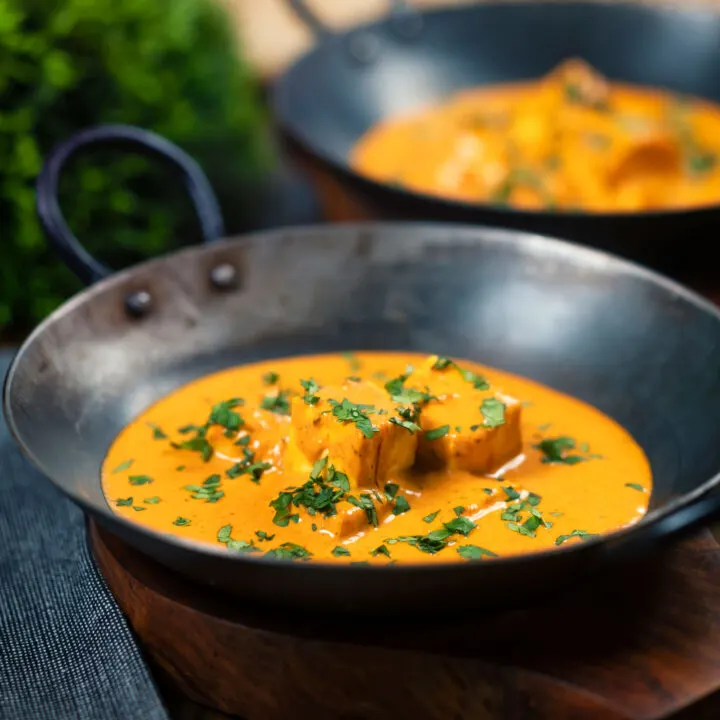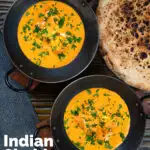Shahi paneer is a rich and indulgent but mild curry recipe that features Indian cheese poached in a silky smooth yoghurt and cream sauce.
The instructions may seem overwhelming, but the dish is essentially 4 easy to make “pastes” that are added to the pan with some spices… and a mini blender does all of the work!
Mughlai Paneer Curry
Mughlai shahi paneer is an Indian curry that has, according to many, been kicking around in Indian food since Mughal times.
That means that this wonderfully rich and delicious curry is somewhere between 300 and 500 years old.
It is deliciously simple in its structure, it is essentially an onion and tomato paste cooked with cream (I also use yoghurt) and spices. Then paneer cheese is poached in the sauce before being served.
I love paneer, however, I was very much late to the party, I never quite got it and confess to being a bit of a meat fiend when I was younger.
But now curries like my palak paneer, Malai kofta or matar paneer are just as likely to appear on my table as a lamb bhuna. I’ve even started using halloumi cheese in a curry!
The flavours in this recipe are very much mellowed and sweetened by the heavy dairy content and whilst the flavours are complex, shahi paneer is not spicy hot.
It’s a wonderfully different curry from the usual British Indian curry house affair and magic because of that difference.
Frequently Asked Questions
What’s the difference between shahi paneer, paneer tikka masala and butter paneer?
In terms of what they are, there is very little difference, each cook will have their own interpretation and that will define how close these dishes are to each other.
However, tikka should contain some form of grilled or cooked element.
In terms of history, Shahi Paneer is the original dish dating back to the Mughal empire which ruled for around 250 years from the mid-16th Century.
The name Butter or Makhani as a suffix or prefix name for a curry dates from the mid-20th century.
Tikka masala is a name that was adopted by British Indians and Bangladeshis towards the mid-late 20th century.
Can I make my own paneer?
Yes, absolutely, I have instructions to make paneer on the stovetop in my aloo paneer recipe.
You can also make paneer in an Instant Pot if that is your thing, I prefer the former.
Do I have to use the saffron?
No, you can skip it if you wish, I get it, it is very expensive.
This will change both the appearance of the curry and the flavour.
Can I make this in advance?
No, although you could make the sauce in advance, then reheat it and add the panner in fresh just before serving.
If you reheat paneer it goes rubbery and as a result, is not the nicest thing to eat.
Can I make this low-fat or lower in calories?
Honestly, I would not bother trying. As I mentioned above the name shahi paneer translates to royal paneer, it is meant to be rich, changing that would ruin the dish for me.
Serving Suggestions
Like most of my curry recipes, I like to serve my shahi paneer with some flatbread.
My choice would be my tandoori-style naan bread, that wonderful thick sauce is perfect for naan. However, a thinner flatbread like a chapati or roti would work well too.
Rice is always a great option with a curry too. I usually opt for plain rice, but a nice pilau rice or jeera rice would be awesome too.
I would personally skip the rice though and add starters into the mix. In particular a big pile of poppadoms, some kachumber salad, mango chutney and a raita!
Equipment Used
I only mention brands of equipment if I think they make a material difference to a recipe. But if you have any questions feel free to ask them in the comments section below the recipe.
- Stovetop.
- 18cm or 7″ saucepan with a lid.
- 12-15cm or 5-6″ sauce or milk pan.
- Wok, I use a large carbon steel wok with a flat base because I find it the best for use on an induction hob.
- Mini blender.
- Kitchen knife.
- Chopping board.
- Weighing scales and or measuring jug, cups and spoons.

Shahi Paneer Curry Recipe
Shahi paneer is a Mughlai curry with a long old history, it translates to "royal" paneer and features a suitable rich creamy sauce with a relatively mild heat level and the unmistakable flavour of saffron.
Ingredients
- 200g (7oz) Paneer
- 2 (200-250g Total) Tomatoes
- 1 Tbsp Ghee
- 3 Tbsp Natural Yoghurt
- 1 Tbsp Kashmiri Chilli Powder
- ½ Tsp Ground Turmeric
- ½ Tsp Salt
- 1 Tsp Garam Masala
- 1 Tsp Dried Fenugreek Leaves
- 1 Pinch Cardamom Powder
For the Cashew Paste:
- 20g (Around 12) Raw Cashew Nuts
- 35ml (2 Tbsp) Boiling Water
For the Onion Paste:
- 70g (2 Small-Medium) Banana Shallots
- 2 Garlic Cloves
- 35g (Thumb sized piece) Ginger
- 1 Green Chilli Pepper
- ½ Tsp Cumin Seeds
- 6 Curry Leaves
- 1 Tbsp Cooking Oil
- 50ml (3 Tbsp + 1 Tsp) Water
For the Saffron Cream:
- 175ml (¾ Cup) Double (Heavy in the US) Cream
- Pinch of Saffron Strands
Instructions
- Pour the boiling water over the cashew nuts and let them sit whilst you make the other pastes.
- Cut the shallots in half, peel them then cut them into a touch 1cm (½") dice.
- Peel the garlic cloves and roughly chop them.
- Peel the ginger and roughly chop it.
- Cut the chilli pepper in half lengthways.
- Heat a 18cm or 7" saucepan over a low-medium heat and add the oil when it is hot followed by the cumin seeds, green chilli and curry leaves, then cook for 30 seconds.
- Throw in the shallots, garlic and ginger and gently cook for 4-5 minutes stirring constantly.
- Pour in the water then add a lid and cook for 12-15 minutes, or until the shallots are very soft.
- Whilst the shallots are softening place the cream in a small (12-15cm or 5-6" ) milk pan and heat it until it begins to bubble at the sides, but do not boil. Then stir in the saffron and remove the pan from the heat and set aside.
- Transfer the shallot mix to a mini blender and blitz to a very smooth paste and transfer to a bowl.
- Roughly chop the tomatoes and add them to the blender and blitz them to a smooth paste, then transfer them to a separate bowl.
- Wipe out the blender, you don't need to be too fastidious with this, then add the soaked cashew nuts and blend them to a smooth paste.
- Cut the paneer into a 25mm (1") dice.
- Heat a wok over a medium-high heat and add the ghee.
- When the ghee has melted add the blended onion mix and fry for 3-4 minutes to drive off the water.
- Add the Kashmiri chilli powder, turmeric and salt, then cook for 30 seconds.
- Pour in the blended tomatoes and cook until the mixture is almost dry, then reduce the heat to low.
- Spoon in the yoghurt and stir for a minute or two.
- Add the garam masala then pour in the saffron cream and the cashew paste and cook for 3-5 minutes, or until the dish thickens.
- Crush the dried fenugreek between the palms of your hands into the wok and add the paneer and cook until the paneer is warmed through, this should only take 1-2 minutes.
- Remove from the heat and stir through the cardamom powder then serve immediately.
Nutrition Information:
Yield:
2Serving Size:
1Amount Per Serving: Calories: 1014Total Fat: 89gSaturated Fat: 48gTrans Fat: 2gUnsaturated Fat: 33gCholesterol: 229mgSodium: 1577mgCarbohydrates: 32gFiber: 6gSugar: 15gProtein: 28g
Calorific details are provided by a third-party application and are to be used as indicative figures only.








